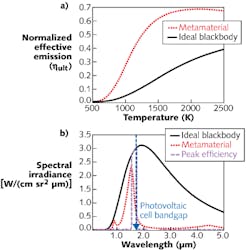Thermophotovoltaic (TPV) semiconductor devices are, in essence, infrared (IR) versions of solar cells. Rather than collecting power from sunlight, however, they are intended for use as collectors and converters of heat into electrical power—in particular, the waste heat from electrical powerplants, automobiles, and other combustion-driven processes. (In addition, even solar cells lose power to thermal losses that could be collected by TPVs.)
But radiated heat normally comes in the form of blackbody (or close to it) radiation, some of which falls outside the TPV device’s spectral collection region. To get around this problem, the TPV device ideally should contain an emissive surface that, when heated, emits IR radiation in a narrower band that falls substantially within the collection band of the semiconductor.
However, previous attempts to engineer a surface or structure to tune its emission spectrum for this purpose have not produced a broadly practical approach—especially because such an emitter is most useful if it works at high temperatures that are difficult to achieve with conventional materials.
ENZ and ENP metamaterials
A group at the University of Alberta (Edmonton, AB, Canada) has designed a plasmonic-metamaterial-based emitter that, based on computer models, should achieve the omnidirectional thermal emission, narrowband and high emissivity, and polarization insensitivity needed for efficient TPV use.1 In addition, the emitter can be fabricated from materials with high melting points.
The materials are called epsilon-near-zero (ENZ) and epsilon-near-pole (ENP) metamaterials; the latter is the new class of artificial media that the researchers designed. The materials contain resonances that allow spectrally narrow bands of optical absorption and thermal emission.
Epsilon-near-zero resonances have low loss, but an enhanced emissivity for only one polarization; using design tricks to get around this results in an increased spectral width. Epsilon-near-pole resonances, however, operate in a very dispersive region, allowing accurate spectral control even with some loss.
The researchers designed two emitters, one based on a planar material stack (1D) and the other on embedded nanowires (2D). The 1D structure is made of alternating layers of metal and dielectric—for example, tantalum (Ta) and titanium dioxide (TiO2). But the characteristics of the 1D structure, such as its dispersion, limit its usefulness. The 2D nanowire structure allows free electron propagation only along the optical axis, and thus has properties in which the ENP and ENZ resonance conditions are aligned, producing the desired isotropic emissivity over a narrow bandwidth.
While previous optical metamaterial applications have been restricted to temperatures of about 300 K and below, the researchers chose materials suitable for use up to 1500 K—where the power density of a blackbody emitter reaches a range high enough for practical TPV conversion. Along with Ta and TiO2, these materials include titanium nitride (TiN) and aluminum zinc oxide (AZO).
Calculations were done comparing the ultimate efficiency of a TiN metamaterial emitter to that of an ideal blackbody with a 0.71 eV material bandgap (see figure). At 1500 K, the efficiency of the metamaterial was more than twice that of the ideal blackbody (the emitter materials themselves should be thermally stable up to 1650 K). The researchers say that, for emitter temperatures of greater than 1000 K, the spectrally thin peaks produced by ENP devices produce higher TPV efficiencies than to spectrally broader emission from ENZ devices.
Zubin Jacob, one of the researchers, notes that the group is now fabricating these high-temperature metamaterials at the University of Alberta, adding that only standard fabrication approaches are needed.
REFERENCE
1. S. Molesky et al., Opt. Exp., 21, S1 (Jan. 14, 2013).

